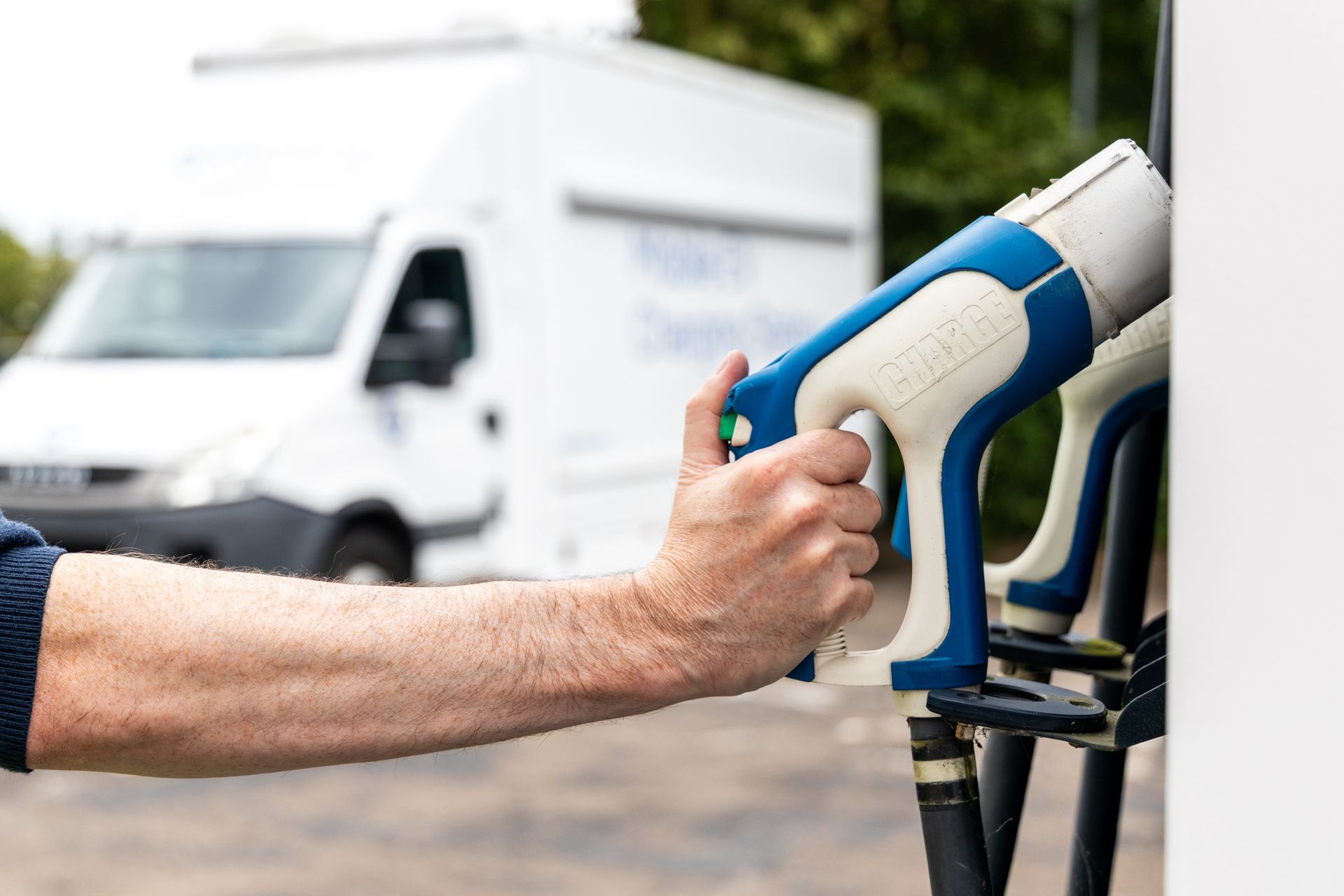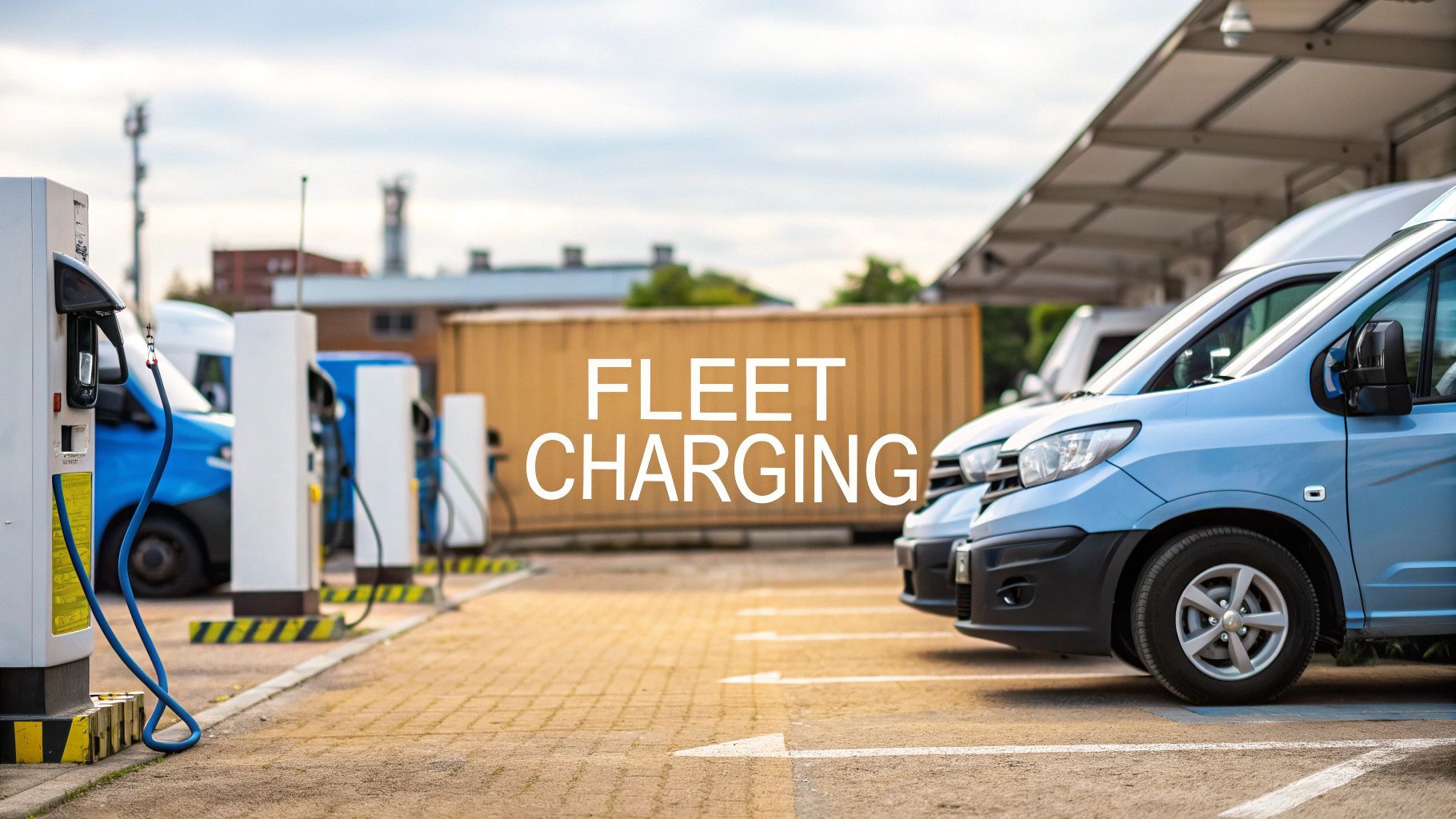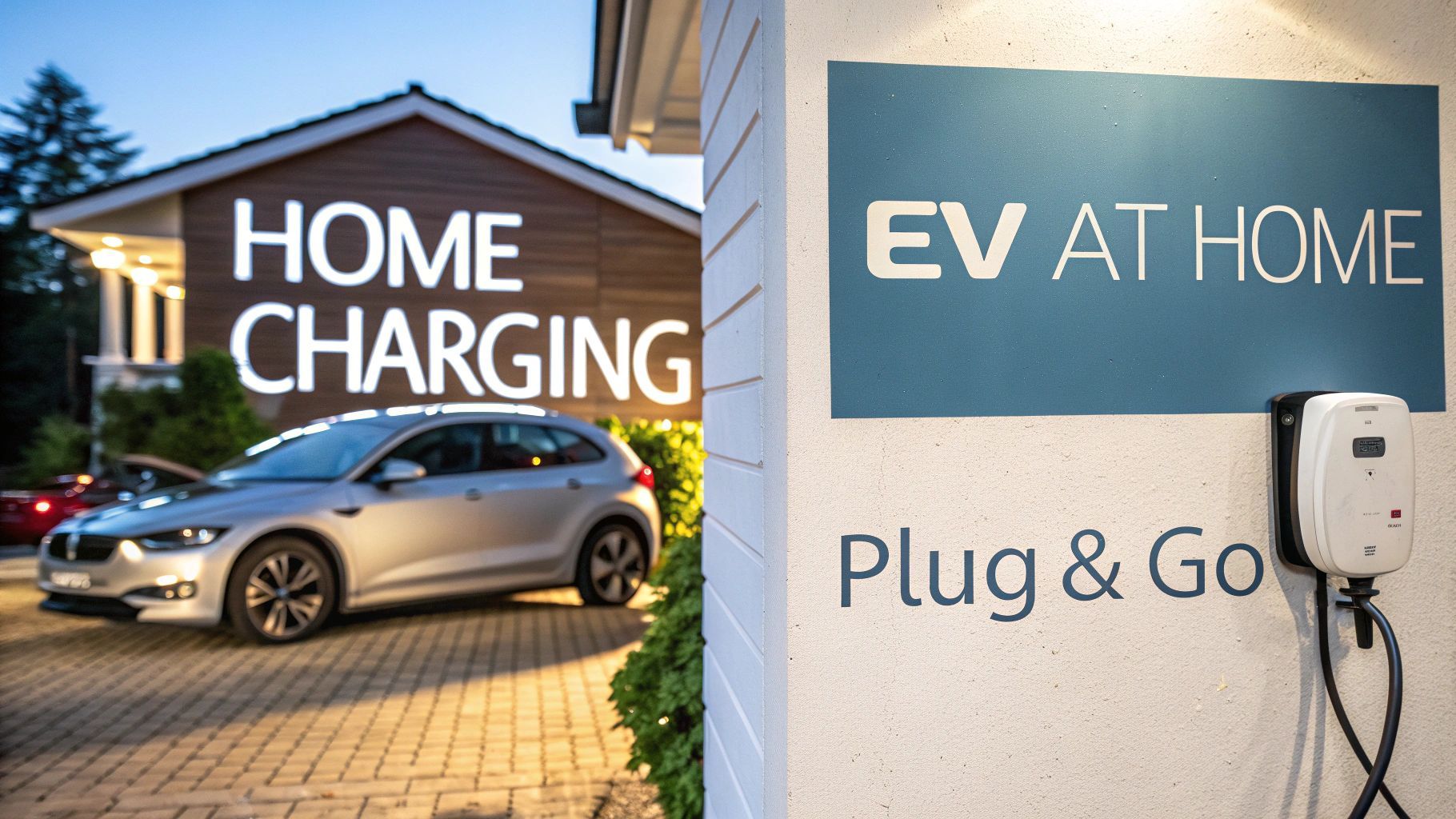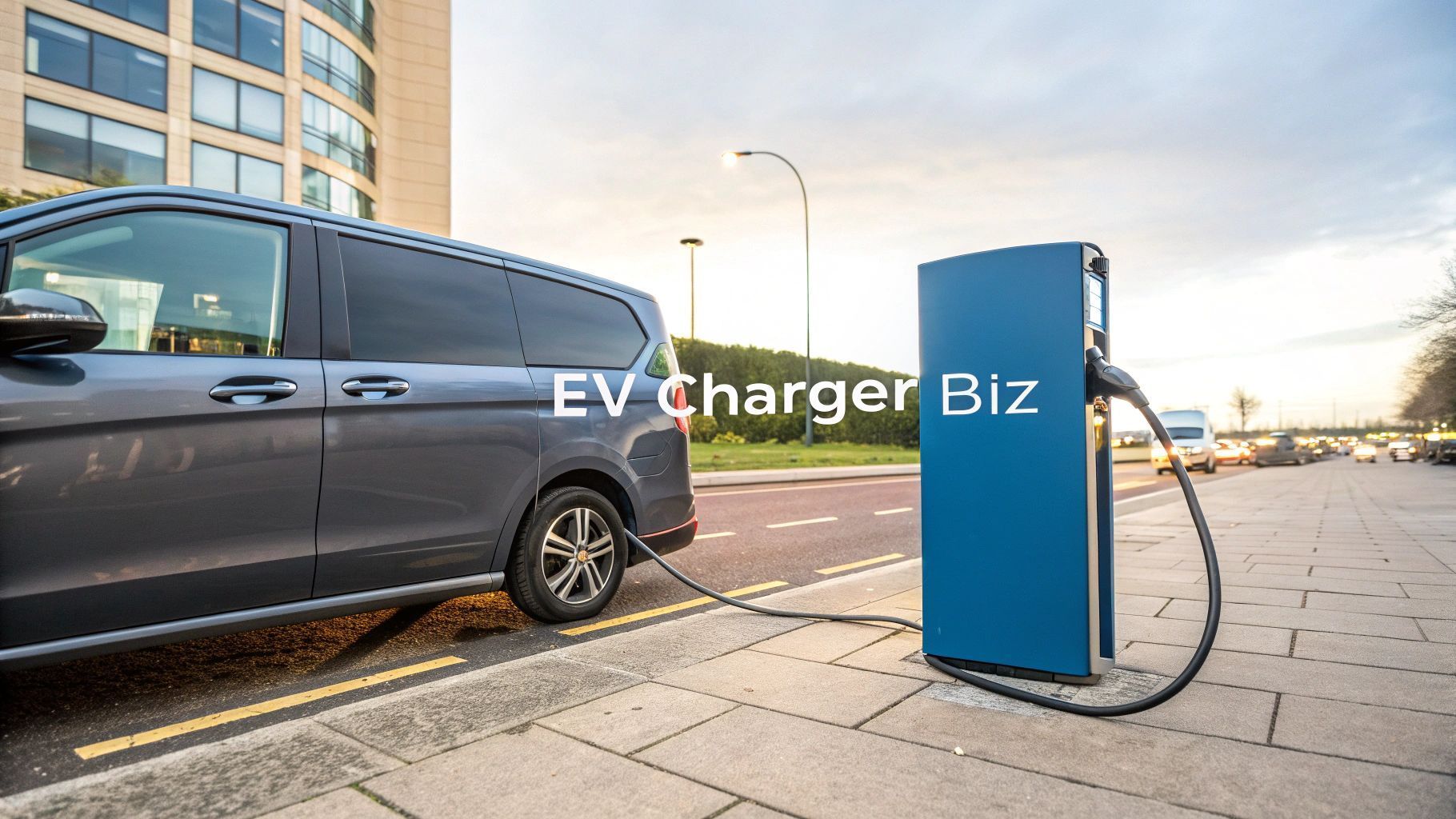Best Battery Charger for Car: Top Picks & Buying Guide
We've all been there. You turn the key in the ignition and instead of the familiar roar of the engine you get a pathetic click. Nothing. A flat battery can instantly ruin your day, leaving you stranded and at the mercy of expensive breakdown services. But what if a major headache could be turned into a minor inconvenience?
That's where a good battery charger for car use comes in. This guide is your roadmap to understanding these essential tools, from the simple chargers you keep in your garage to the world of mobile charging businesses.
Your Guide to Never Getting Stranded Again
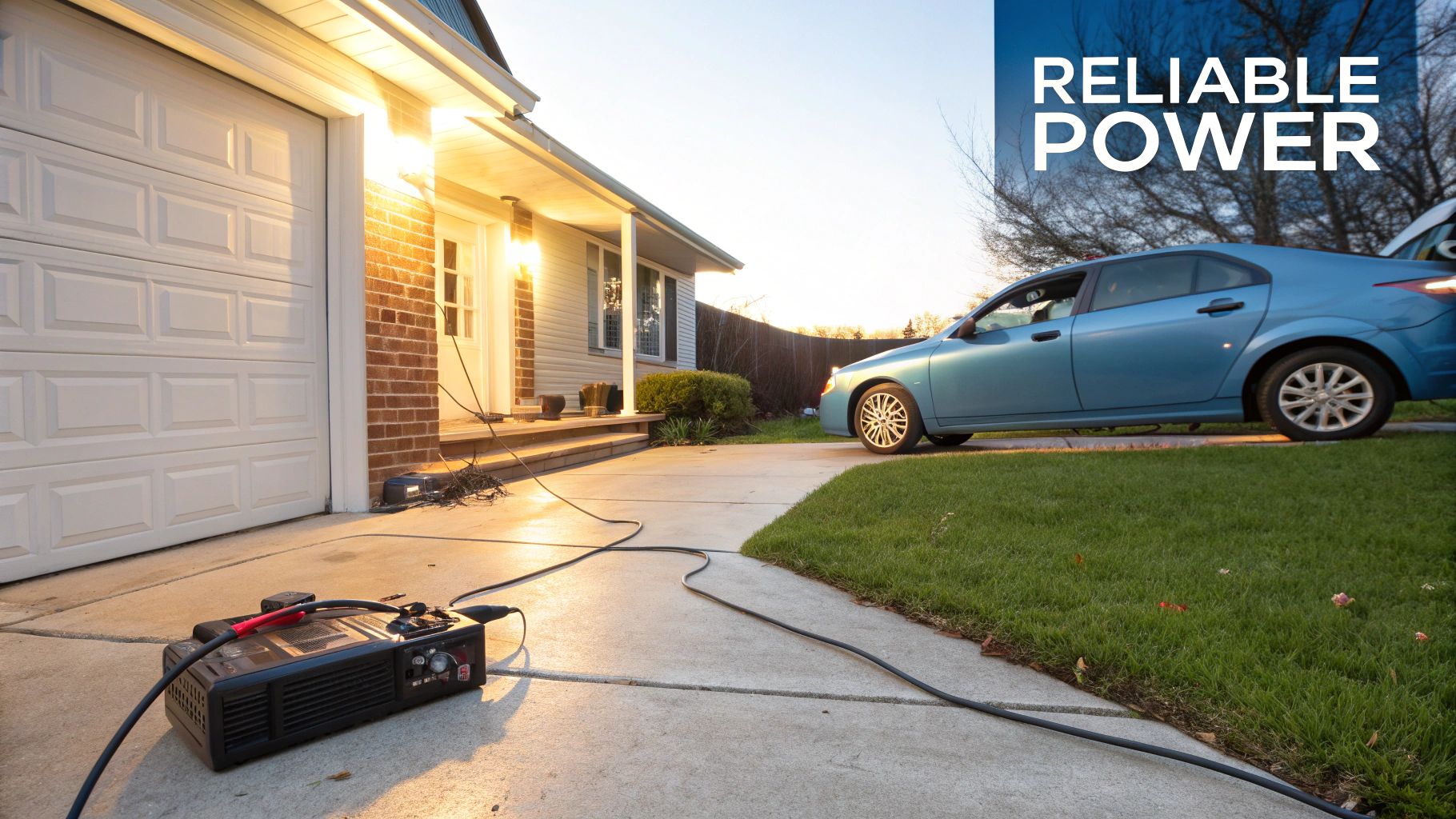
There’s no feeling quite like the slow dread that comes with a dead battery. It always seems to happen at the worst possible moment, derailing your plans and leaving you stuck. A quality battery charger for car use is your best defence against this all-too-common problem.
Think of your car's battery as a rechargeable power bank for your vehicle. Every time you start the car or use the radio with the engine off, you're draining its power. Your car's alternator does a decent job of topping it up while you drive but short trips, cold weather or leaving the car unused for a while can leave the battery seriously depleted. A charger simply acts as an external power source, carefully refilling the battery’s energy reserves.
This does more than just get you ready for your next trip. Regularly topping up your battery can dramatically extend its lifespan, saving you the hassle and cost of buying a replacement sooner than you need to.
The Rise of Mobile Charging Services
The idea of charging a vehicle is no longer limited to a plug in your garage. With the massive shift towards electric vehicles (EVs), a whole new and lucrative market has opened up for mobile charging operators. These entrepreneurs are essentially providing on-demand roadside assistance, bringing the power directly to EV drivers who have run out of juice.
The business model is built on pure convenience and necessity, offering a lifeline where public charging points are miles away or all occupied. An operator can build a healthy business through a mix of call-out fees and charging a price per kilowatt-hour of energy delivered.
A single mobile charging van, operated efficiently, can realistically generate upwards of £1,000 per week . This figure really highlights the demand for flexible charging solutions and the financial potential for anyone looking to get into this growing market.
If you're a business exploring this space, it’s worth seeing how mobile charging can bolt onto existing services. You can get more detail on https://www.zapme.biz/how-zapme-enhances-ev-roadside-assistance-services.
Finally, never underestimate the power of good maintenance. A charger is one part of the puzzle but keeping the battery itself in top condition is crucial for reliability. Learning how to clean your car battery is a simple step that can significantly extend its life and prevent future breakdowns.
Comparing The Different Types of Car Battery Chargers
As you can see, there’s a massive speed difference between a fast charger and a standard trickle model. The best choice for you really comes down to balancing raw speed against what your battery actually needs, whether that’s a quick emergency jump or slow, steady care over the long term.
Picking the right battery charger for car use isn't as simple as grabbing the first one you see. The market is packed with options, each built for a different job – from gentle, long-term maintenance to a powerful kickstart when you're in a jam.
Getting your head around the main types is the key to protecting your battery and getting real value for your money. It all depends on how you use your car and what you need that charger to do.
Trickle Chargers For Gentle Maintenance
A trickle charger is the most basic type you can get. It feeds a very low, constant electrical current into the battery, just enough to stop it from naturally losing its charge over time.
This makes it perfect for vehicles that sit idle for long periods. Think of a classic car tucked away for the winter or a motorbike you only take out on sunny weekends.
But there's a catch. A classic trickle charger never stops charging. If you leave it connected for too long without keeping an eye on it, it will eventually overcharge and damage the battery. They’re best used for short stints or hooked up to a separate timer.
Smart Chargers For Optimal Battery Health
The modern answer to this problem is the smart charger , sometimes called a battery maintainer. These devices are in a different league entirely. They have an onboard processor that constantly monitors the battery’s health, automatically adjusting the charge through several stages.
A smart charger will deliver a strong current when the battery is low, then ease off as it gets full, eventually switching into a "float" or "maintenance" mode. This keeps the battery at its ideal charge level without any risk of overcharging.
This intelligent approach doesn't just protect the battery from damage; it can actually extend its lifespan by preventing the harm caused by both undercharging and overcharging. For most drivers, a smart charger is the ideal blend of safety, efficiency and long-term care.
Jump Starters For Roadside Emergencies
Finally, we have jump starters, which are built for a completely different reason. A jump starter isn't designed to fully recharge a battery. Its job is to deliver a massive jolt of power in one short burst.
This gives the engine just enough juice to crank over and get you back on the road. They are compact, portable lifesavers for those unexpected flat-battery moments.
The demand for all these charging solutions is growing fast. The UK's battery charger market was valued at around $840.88 million in 2024 and is expected to climb to $1.28 billion by 2034, largely thanks to the rise of electric vehicles and smarter tech. You can read the full research on the UK's battery charger market to dig deeper into these trends.
To make things even clearer, let's break down the main types side-by-side.
Comparison of Car Battery Charger Types
This table gives a quick overview of how each charger type stacks up, helping you match the right tool to the right job.
| Charger Type | Primary Use | Best For | Pros | Cons |
|---|---|---|---|---|
| Trickle Charger | Slow, long-term maintenance | Vehicles in storage (classic cars, motorbikes, boats) | Simple, affordable, prevents self-discharge | Can overcharge if left connected indefinitely, slow |
| Smart Charger | All-purpose charging & maintenance | Everyday car owners, long-term battery health | Multi-stage charging, prevents overcharging, extends battery life | More expensive than trickle chargers |
| Jump Starter | Emergency engine starting | Roadside emergencies, unexpected flat batteries | Portable, powerful burst of energy, gets you moving quickly | Doesn't recharge the battery, limited use |
Ultimately, the best charger depends entirely on your needs. A jump starter is a must-have for emergencies, while a smart charger offers the best all-round solution for keeping your battery in top condition day-to-day.
Decoding the Features That Truly Matter
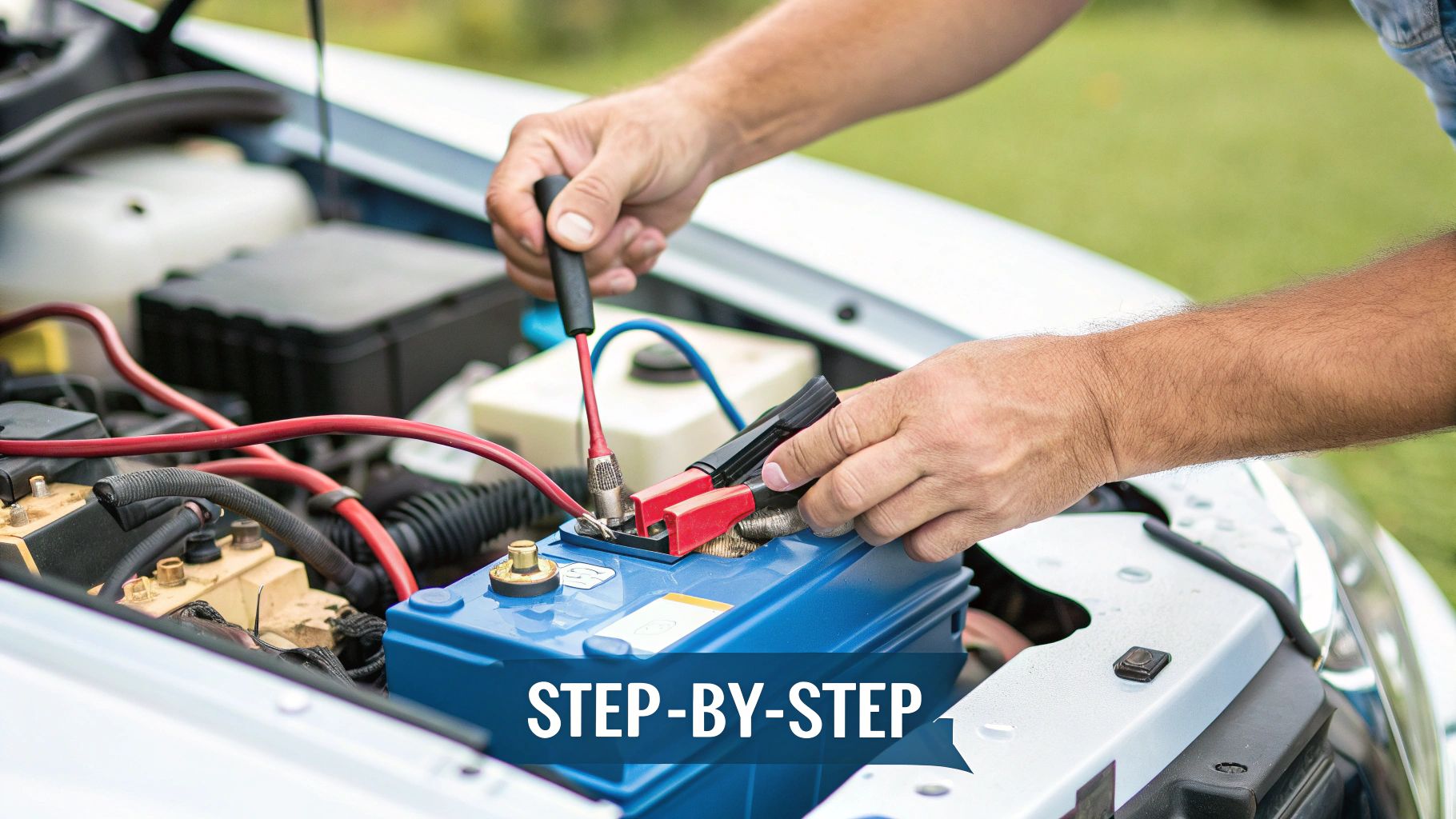
Choosing the right battery charger for car use isn’t about picking the flashiest brand. It's about looking at the tech that actually keeps you safe and your battery healthy. Understanding just a few key specs is all it takes to make a confident choice that will genuinely serve you well.
The most fundamental feature is voltage . For almost every car and light van on UK roads, this will be 12V . Matching this is non-negotiable but thankfully it’s standard on most chargers out there. The next number to look at is the amperage (A), which dictates how quickly the battery charges. A simple 2A charger is perfectly fine for overnight top-ups but a 4-8A model will get a flat battery ready to go much, much faster.
Essential Safety Protections
Any decent modern charger is packed with safety features to protect both you and your vehicle’s sensitive electronics. These aren’t just nice-to-have extras; they’re essential functions that prevent costly mistakes.
At a bare minimum, look for a charger with these two core protections:
- Reverse Polarity Protection: This is a lifesaver. It stops any damage if you accidentally connect the clamps to the wrong battery terminals. The charger simply won’t send any power until you get it right.
- Short-Circuit Prevention: This feature ensures the clamps aren’t ‘live’ until they are properly connected to a battery. It’s what stops them from sparking if they happen to touch each other.
These automated checks give you crucial peace of mind, especially if you’re not a seasoned mechanic.
The Power of Smart Charging
Beyond basic safety, the best modern chargers use smart technology to manage the whole process intelligently. This is particularly important for newer battery types like AGM, gel and lithium-ion, which demand very specific care.
A smart charger automatically figures out the battery type and its current condition. It then adjusts the charging cycle through multiple stages to get the best performance and prevent any damage. It's this adaptability that really sets a quality charger apart from a basic one.
The demand for these advanced features is a key reason the market is expanding so quickly. Globally, the car battery charger market is projected to grow from $24.9 billion in 2025 to $44.9 billion by 2035 . This growth is fuelled by a clear consumer shift towards smarter, more capable chargers. You can discover more insights about car battery charger market trends on futuremarketinsights.com.
Smart technology is no longer just a premium feature. It's a necessity for extending battery life and ensuring safe, reliable operation. It allows the device to think for itself, protecting your investment.
These features are especially vital in the commercial world, where reliability is everything. The advanced technology found in ZAPME mobile chargers for EV fleets is built on these exact same principles: safety, smart functionality and broad compatibility.
The Rise of Mobile Charging as a Business
The electric vehicle revolution isn’t just changing how we drive; it’s unlocking entirely new ways to do business. One of the most interesting is mobile EV charging, a service that turns the headache of a dead battery into a profitable venture for sharp entrepreneurs. In this model, a van kitted out with a powerful battery charger becomes a rescue service for stranded EV drivers.
This business thrives on flexibility and need. An operator can go wherever the demand is, from a packed city centre to a remote spot miles from the nearest fixed charging point. With much lower overheads than installing and maintaining a permanent station, a mobile service is a faster, more accessible way into the booming EV market.
Calculating Your Potential Earnings
The profitability of a mobile charging business comes down to two main income streams: a fixed call-out fee and a per-kilowatt-hour (kWh) charge for the energy you deliver. This simple structure makes sure every job is profitable, covering both your time and the electricity supplied.
Let's run through what a single operator could realistically earn. A typical mobile charging job might look like this:
- Call-Out Fee: A standard charge of £30 - £50 just for driving out to the vehicle.
- Energy Pricing: Charging around 75p per kWh , which is competitive with public rapid chargers but with the massive bonus of convenience.
- Average Job Size: Delivering 15-20 kWh per visit, which is enough to give an EV around 60-80 miles of range.
Based on these figures, a single job can bring in anywhere between £41 and £65 . Just four or five of those a day and you're looking at a pretty serious income.
From Daily Income to Annual Profit
When you scale that up, the financial potential becomes crystal clear. A busy operator can see some impressive returns. The ability to serve customers anywhere, anytime, creates a high-value service that people are more than willing to pay for.
By focusing on high-demand areas or partnering with roadside assistance firms, a single-van operation could realistically aim for a weekly revenue of £700 to £1,200 . This translates into a potential annual turnover of over £50,000 for one person.
The UK's commitment to EVs is directly fuelling this demand. The market for EV charging equipment is set to explode, with installations projected to climb from 64,360 in 2025 to 169,150 by 2030. This rapid growth is creating a huge customer base just waiting for mobile charging services.
To give you a clearer sense of the numbers, here's a sample breakdown of what a mobile charging operator could earn in a week.
Potential Weekly Earnings for a Mobile Charging Operator
An example breakdown of potential revenue and profit for a single-van mobile charging operation, based on industry averages for pricing and job frequency.
| Metric | Low Estimate | Average Estimate | High Estimate |
|---|---|---|---|
| Jobs Per Week | 15 | 20 | 25 |
| Average Revenue Per Job | £45 | £53 | £60 |
| Total Weekly Revenue | £675 | £1,060 | £1,500 |
| Weekly Fuel/Energy Costs | £100 | £130 | £160 |
| Other Weekly Expenses | £75 | £100 | £125 |
| Weekly Profit | £500 | £830 | £1,215 |
As the table shows, even on a conservative estimate, the business is highly profitable. A well-run mobile operation isn’t just a job; it’s a scalable and lucrative business that’s perfectly positioned for the future of transport.
If you want to see a full, real-world breakdown of this business model, it's worth digging into the numbers. You can get all the details in our article on the economics of mobile EV charging.
How to Use Your Car Battery Charger Safely
Owning a car battery charger is one thing but knowing how to use it properly is what really matters for your safety and your vehicle’s health. Modern chargers are packed with safety features but sticking to a clear, step-by-step process turns what can feel like an intimidating job into a simple bit of routine maintenance. The goal here is simple: prevent dangerous sparks and get a solid, effective charge every time.
Before you even think about plugging anything in, safety has to come first. Working with car batteries always carries a small but real risk, so taking a moment to get the area ready is non-negotiable. A few basic precautions make all the difference.
Preparing for a Safe Charge
Always start by setting up in a well-ventilated space. An open garage with the door up or a sheltered spot outdoors is perfect. Batteries can release a small amount of hydrogen gas when they charge, which is flammable, so good airflow is crucial to stop it from building up.
Next, grab your protective gear. It might feel like overkill but it’s just smart.
- Protective Eyewear: Always, always wear safety glasses or goggles. This is your best defence against any stray sparks or an unlikely splash of battery acid.
- Gloves: A decent pair of work gloves will protect your hands from the usual grime and any corrosive gunk that might be lingering on the battery terminals.
- Check the Charger: Make sure your charger is switched off at the unit and unplugged from the wall before you connect a single clamp.
These simple steps create a controlled environment, cutting down the risks so you can focus on the job at hand.
The Connection Sequence
Getting the clamps connected in the right order is the most critical part of this whole process. Getting it wrong is how sparks happen and sparks are exactly what you want to avoid around a battery. The rule is easy to remember: positive on, positive off, negative on, negative off .
Here’s the correct, safe way to connect your charger:
- Attach the Red Clamp: First, connect the red (positive) clamp to the red (+) terminal on your car battery. Make sure it has a firm, secure grip.
- Attach the Black Clamp: Now, connect the black (negative) clamp to a solid, unpainted metal part of the car's chassis or the engine block itself. This is known as ‘grounding’ the connection and is far safer than clamping directly onto the negative battery terminal.
- Power On the Charger: With both clamps securely in place, you can now plug the charger into the mains and switch it on.
- Select the Mode: Use the display to choose the right charging mode for your battery type (e.g., AGM , standard lead-acid) and the amperage you need.
- Disconnecting Safely: Once the charge is complete, you just reverse the process. Switch off and unplug the charger from the mains first. Then, remove the black clamp from the chassis and finally, take the red clamp off the battery terminal.
Following this "positive on first, positive off last" sequence minimises the risk of creating a spark right next to the battery terminals, which is the absolute cornerstone of safe charging. By grounding the negative connection away from the battery, you create a much safer circuit.
Simple Steps to Maintain Your Charger
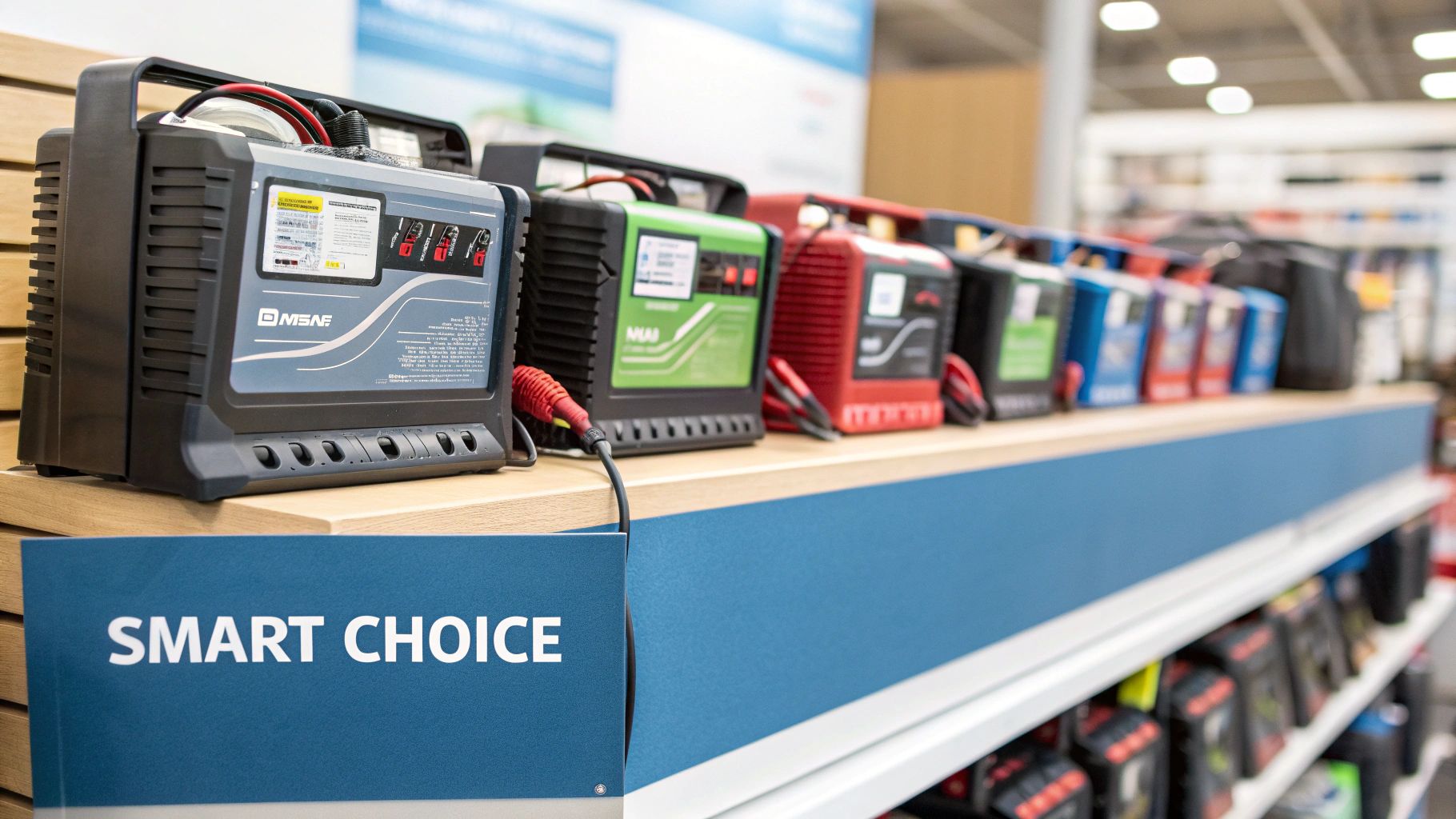
Your car battery charger is a tough bit of kit but like any tool, a little looking after goes a long way. It only takes a moment but proper care ensures it’s ready to rescue you when you need it most. After all, a well-maintained charger is a dependable one.
The best habit you can get into is a quick visual once-over before you plug it in. Run your eyes along the power cord and the charging cables. Look for any cracks, fraying or exposed wires. Damaged cables are a serious safety risk and need sorting immediately.
Keep It Clean and Connected
Dirt and corrosion are the mortal enemies of a good electrical connection. The metal clamps on your charger have to make solid, clean contact with the battery terminals to do their job properly.
A simple clean-up routine will make a massive difference to your charger’s lifespan:
- Wipe Down the Clamps: Once you’re done, give the clamps a quick wipe with a dry cloth to get rid of any grease or grime.
- Banish Corrosion: If you see any of that crusty white or greenish build-up, a stiff wire brush will scrub it away. This guarantees a clean, powerful connection every single time.
- Check the Springs: Give the clamps a squeeze. Make sure the springs still feel strong and give a tight grip. A loose clamp can mean an inefficient charge or no charge at all.
Smart Storage for a Long Life
Where you keep your charger has a huge impact on its health. Those delicate electronics inside aren't fans of extreme conditions, so a bit of thought here will protect your investment.
Always store your charger in a dry, cool spot away from direct sunlight and dampness. A shelf in the garage or a dedicated storage box is perfect. This simple step stops humidity from wrecking the internal circuits and prevents the plastic casing from going brittle over time.
Following these straightforward steps means your car battery charger will stay reliable for years to come. A few minutes of care prevents unexpected failures and ensures it’s ready to perform flawlessly whenever a flat battery threatens to ruin your day.
Frequently Asked Questions About Car Battery Chargers
Even with the best guide, stepping into the world of car battery chargers can leave you with a few lingering questions. It's completely normal. This final section tackles some of the most common queries we hear, giving you straightforward answers so you can use your charger with total confidence.
Think of this as the last piece of the puzzle. Getting these details right ensures you'll handle your equipment correctly and keep your battery in prime condition for years to come.
How Long Does It Take to Charge a Car Battery?
This is the classic "how long is a piece of string?" question. The honest answer is: it really depends. The charging time comes down to three key things: the battery's size, how flat it is and the amperage (A) of your charger.
A low-power trickle charger, pushing out just 1-2A , is built for slow, steady maintenance. It could take a full 24-48 hours to bring a dead battery back to life. A standard 4-8A smart charger, on the other hand, can usually get the job done in 6-12 hours . If you're using a powerful fast charger, you might only need 1-4 hours but you have to be careful not to stress the battery.
Can I Leave a Charger Connected All the Time?
You can but only if it’s a modern smart charger. These devices are specifically designed for long-term hook-ups. Once the battery is full, they automatically switch over to a 'float' or 'maintenance' mode. This just trickles in a tiny bit of power to counteract the battery's natural self-discharge, keeping it topped up and ready to go.
Never leave a basic, old-school charger connected indefinitely. It doesn’t have the brains to stop charging and will eventually cook your battery, causing permanent damage. For true 'set-and-forget' peace of mind, a smart charger is the only safe choice.
Should I Charge the Battery In or Out of the Car?
For almost all modern cars and smart chargers, it’s perfectly safe to charge the battery while it’s still connected and sitting in the vehicle. The golden rules are to make sure the ignition is completely off and that there's good ventilation around the car.
The main reasons you might want to remove a battery for charging are if it’s in a really awkward spot or if you’re using an older, less sophisticated charger that could potentially mess with the car's sensitive electronics.
What Is the Difference Between a Charger and a Jump Starter?
This is a really important distinction. A battery charger is designed to slowly and carefully refill a battery's energy over several hours, restoring it to full health. It’s a tool for maintenance and recovery.
A jump starter, on the other hand, is an emergency device. It’s all about brute force. It delivers a very powerful but short burst of energy—just enough to crank the engine and get you started. It doesn’t actually charge the battery; you’ll still need to let the engine run for a while or connect a proper charger afterwards to do that.
Ready to explore the future of vehicle charging? ZAPME offers cutting-edge mobile solutions for every EV need. Discover more at https://www.zapme.biz.

